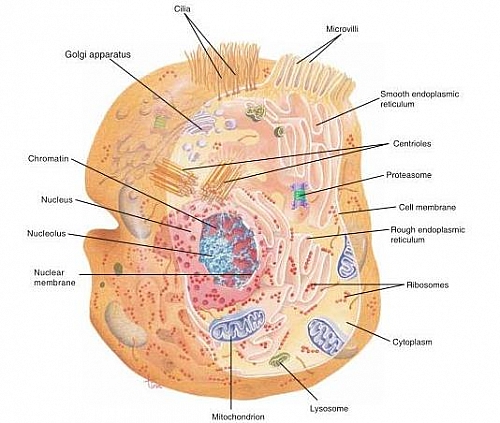Table of Contents
Cytoplasm Definition
The Cytoplasm of both plant cells and animal cells is the jellylike material formed by 80% of the water that contains a clear liquid portion called the cytosol and various particles of different shapes and sizes; these particles are proteins, carbohydrates, lipids, or electrolytes in nature. It also contains many organelles with distinct structures and functions.
What is Cytoplasm?
The Cytoplasm is the part of the cell located outside of the nucleus that is bounded cell membrane. It is composed of different organic and inorganic compounds like water, different nucleic acids, and enzymes. The outer area of cytoplasm is more concentrated, less granular, and hard, this is called the Ectoplasm; while the central area that is less concentrated is called the Endoplasm; the cytoplasm is therefore made of Endoplasm and Ectoplasm.
It houses different organelles like plastids, mitochondria, endoplasmic reticulum, ribosome, Golgi bodies, lysosome, centrosome, and different nonliving substances.
The outer part of the cell is termed the cytoplasm, a word derived from the Greek word “Kytos“, which means something that is hollow or covers, and “Plasma“ which means something that is molded. Thus the cytoplasm is essentially molded around the nucleus and it is a watery solution of minerals, gases, organic molecules, and cell organelles that is found between the cell membrane and the nucleus.
Structure
The cytoplasm is made up of two zones:
- Ectoplasm: Peripheral part that is situated just beneath the cell membrane
- Endoplasm: Inner part that is interposed between the ectoplasm and the nucleus.
Cytoplasm Diagram
Cytoplasmic Organelles in Plant and Animal cells
- Plastids
- Mitochondria
- Endoplasmic reticulum
- Ribosome
- Golgi bodies
- Lysosome
- Peroxisome
- Centrioles
- Secretory vesicles
- Centrosome
- Chloroplast
Cytoplasmic organelles are the cellular structures embedded in the cytoplasm, with each organelle having a definite structure and specific functions. These organelles are considered as small organs of the cell. Some organelles are bound by a limiting membrane while others do not have a limiting membrane.
Cytoplasm Functions
The function of the cytoplasm is mainly to hold different organelles and perform some organic functions. It plays an important role in a cell, serving as a “molecular soup” in which organelles are suspended and held together by a fatty membrane.
What does the cytoplasm do?
- It plays a mechanical role by moving around inside the membrane and pushing against the cell membrane helping to maintain the shape and consistency of the cell.
- The cytoplasm provides suspension to the organelles.
- It is a storage space for chemical substances indispensable to life, which are involved in vital metabolic reactions, such as anaerobic glycolysis and protein synthesis.
The Cytosol
The cytosol is the clear fluid portion of the cytoplasm; it is also called Hyaloplasm.
What is Cytosol?
The cytosol is a gel-like fluid portion of the cytoplasm that is crucial to many cell processes. A variety of enzymes in the cytosol catalyze specific chemical reactions in the body such as the ten enzymes that break down one glucose molecule into two molecules of pyruvate during the process of Glycolysis. The cytosol also stores energy in the form of triglycerides or glycogen in masses called inclusion bodies. Molecules that are to be released from the cell, or secreted, are stored in membrane-bound sacs called secretory vesicles; also, the molecular composition of the cytosol is critical to the function of cells as it occurs in nerve cells and muscle cells where the ionic composition of the cytosol plays a crucial role in their activities
Cytosol Functions
- The Cytosol contains hundreds of enzymes, such as those of the glycolytic pathway, that produce building blocks for larger molecules and break down small molecules to liberate energy.
- All the machinery converging on the ribosomes for protein synthesis (mRNA, transfer RNA, enzymes, and other factors) is also contained within the cytosol.
- Oxygen, CO2 , electrolytic ions, low-molecular-weight substrates, metabolites, and waste products all diffuse through the cytosol, either freely or bound to proteins, entering or leaving organelles where they are used or produced.
Cytosol and Cytoplasm
The cytoplasm consists largely of a fluid component named the Cytosol, bathing metabolically active structures called Organelles (some of which may have membranes like Mitochondria while others may not such as protein complexes like the ribosomes and proteasomes. In addition to the organelles, there are protein components of the cytoplasmic cytoskeleton, which determines the shape and motility of eukaryotic cells.

